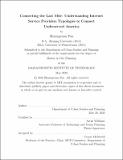Connecting the last mile : understanding internet service providers typologies to connect underserved America
Author(s)
Fan, Zhuangyuan.
Download1193555948-MIT.pdf (25.68Mb)
Alternative title
Understanding internet service providers typologies to connect underserved America
Other Contributors
Massachusetts Institute of Technology. Department of Urban Studies and Planning.
Advisor
Sarah Williams.
Terms of use
Metadata
Show full item recordAbstract
The Internet can bestow significant benefits upon those who use it. The digital divide in the US is widely acknowledged, and a large number of nonprofit organizations, cooperations, local businesses, and companies have devoted their efforts to bridge the gap through their strategies. Given the geographical, financial, and market challenges, many of these entities struggle to balance the two: a mission to bring high-quality Internet to the currently underserved areas and a healthy and sustainable growing organization. Current federal funding programs such as Rural Development Opportunity Fund (RDOF) and Connect American Fund (CAF) do not yet have enough data to identify those Internet Service Providers (ISPs) with a strong social vision or match the quality of service with local demand. Here, by applying a pre-trained Text Entailment Natural Language Processing algorithm, I infer the identity, vision, and goals of more than 1,000 local ISPs using a large number of self-description texts from each ISP's website. Then I create an Internet Service Provider Typology, combined with socioeconomic data of these ISPs' service areas and technical specifications from FCC's Form 477. This typology study deviates from the traditional bifurcating definition of the "for-profits" and the "nonprofits". Instead, it identifies four types of ISPs that highly differentiate from each other in their current primary service markets, identities, and long term visions. The clustering of these typologies illustrates a clear geographical, social, and service quality level division of the current Internet services in the U.S. Planners and policymakers could use this typology study to create specific funding programs and thus effectively address inequality and accelerate the pace to bridge the digital divide.
Description
Thesis: M.C.P., Massachusetts Institute of Technology, Department of Urban Studies and Planning, May, 2020 Cataloged from the official PDF of thesis. Includes bibliographical references (pages 86-89).
Date issued
2020Department
Massachusetts Institute of Technology. Department of Urban Studies and PlanningPublisher
Massachusetts Institute of Technology
Keywords
Urban Studies and Planning.